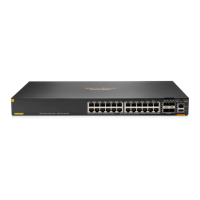10
Configure a multiport ARP entry so that the device sends IP packets with the destination IP address
192.168.1.1 to the three servers.
Figure 5 Network diagram
Procedure
# Create VLAN 10.
<Device> system-view
[Device] vlan 10
[Device-vlan10] quit
# Add GigabitEthernet 1/0/1, GigabitEthernet 1/0/2, and GigabitEthernet 1/0/3 to VLAN 10.
[Device] interface gigabitethernet 1/0/1
[Device-GigabitEthernet1/0/1] port access vlan 10
[Device-GigabitEthernet1/0/1] quit
[Device] interface gigabitethernet 1/0/2
[Device-GigabitEthernet1/0/2] port access vlan 10
[Device-GigabitEthernet1/0/2] quit
[Device] interface gigabitethernet 1/0/3
[Device-GigabitEthernet1/0/3] port access vlan 10
[Device-GigabitEthernet1/0/3] quit
# Create VLAN-interface 10 and specify its IP address.
[Device] interface vlan-interface 10
[Device-vlan-interface10] ip address 192.168.1.2 24
[Device-vlan-interface10] quit
# Configure a multiport unicast MAC address entry that has MAC address 00e0-fc01-0000, and
output interfaces GigabitEthernet 1/0/1, GigabitEthernet 1/0/2, and GigabitEthernet 1/0/3 in VLAN
10.
[Device] mac-address multiport 00e0-fc01-0000 interface gigabitethernet 1/0/1 to
gigabitethernet 1/0/3 vlan 10
# Configure a multiport ARP entry with IP address 192.168.1.1 and MAC address 00e0-fc01-0000.
[Device] arp multiport 192.168.1.1 00e0-fc01-0000 10
Verifying the configuration
# Verify that the device has a multiport ARP entry with IP address 192.168.1.1 and MAC address
00e0-fc01-0000.
[Device] display arp
Type: S-Static D-Dynamic O-Openflow R-Rule M-Multiport I-Invalid

